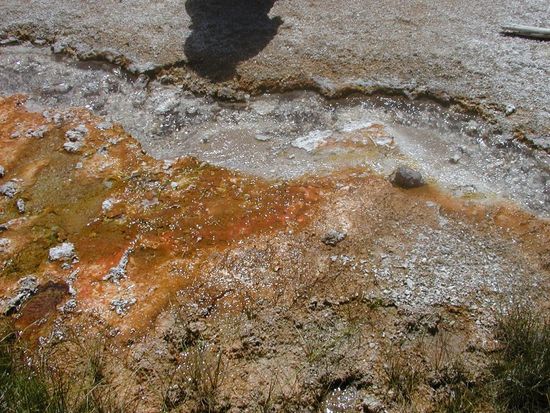Chloroflexus
A Microbial Biorealm page on the genus Chloroflexus

Classification
Higher order taxa:
Bacteria; Chloroflexi; Chloroflexi (class); Chloroflexales; Chloroflexaceae
Species:
Chloroflexus aggregans, Chlororflexus aurantiacus, Chloroflexus sp.
Description and Significance
Chloroflexus aurantiacus is an aerobic facultative bacterium that can photosynthesize in anaerobic situations with processes that are a mix of both purple bacteria and green sulfur bacteria photosynthesis.
Genome Structure
The Doe Joint Genome Institute is currently sequencing Chloroflexus aurantiacus. Examination of this genome and the phylogeny of this bacterium will shed light on the evolution of photosynthesis.
Cell Structure and Metabolism
Chloroflexus is a anoxygenic, filamentous, gliding bacterium found in the green non-sulfur branch in the 16s rRNA tree of life (however, not all Chloroflexus are green and unable to use sulfide). Generally, Chloroflexus is a photogeterotroph and uses organic molecules that are made from other bacteria, but some Chloroflexus strains grow autotrophically and use hydrogen or sulfide as an electron donor. Chloroflexus aurantiacus, which is a facultative aerobic species of Chloroflexus, can do anoxygenic photosynthesis that has characteristics of both green sulfur bacteria and purple bacteria (both of which are not closely related to Chloroflexus) as well as cellular respiration in aerobic environments. However, Chloroflexus bacteria, unlike purple bacteria, lack internal membranes. Chloroflexus aurantiacus also fix CO2 differently from other phototrophs though a pathway called the 3-hydroxypropionate pathway as well as they seem to lack ribulose bisphosphate carboxylase activity. In anaerobic (or semiaerobic) situations, Chloroflexus aurantiacus harvests light in chlorosomes that are slightly smaller that those of green sulfur bacteria and can be found pressed against the cell membrane. The chlorosomes, like those in green sulfur bacteria, contain bacteriochlorophyll c; in addition, light-harvesting complexes containing bacteriochlorophyll a (like in purple bacteria) can be found within the cell membrane. Also like purple bacteria, Chloroflexus bacteria have pheophytin-quione type photochemical reaction centers. (Sprague et al. 1981)
Ecology

Chloroflexus is found at higher temperatures than other anoxygenic phototrophs with an optimal growth between 50 and 60 C (these temperatures found from growing the bacterium in a lab). Generally, Chloroflexus can be found in a number of environment types such as hot springs, lakes, river water and sediments, and in marine and hypersaline environments (list from Prokaryotes). Near hot springs, especially, Chloroflexus can be found in the lower layers of microbial mats with cyanobacteria growing above it. It seems to use the organic products of the cyanobacteria; however, some strains Chloroflexus can also grow alone in springs high in sulfide, which it uses as an electron donor (it can also use hydrogen).
Phylogeny
Chloroflexus bacteria are phylogenetically and phenotypically distant from both green sulfur bacteria and purple bacteria. However, Chloroflexus and purple bacteria have similar photochemical reaction centers (an essential protein containing bacteriochlorophylls for photosynthesis), and Chloroflexus and green sulfur bacteria share similar chlorosome light-harvesting systems. This draws questions on the evolution of photosynthesis. Some try to explain the similar mechanisms in three photosynthetic groups that are so phylogenetically diverse by suggesting horizontal transfers of photosynthetic genes among these groups. Discrepancies also occur within the Chloroflecaceae family due to differences among carbon dioxide fixation pathways. The mesophilic species Oscillochloris trichoides from the family Chloroflecaceae has a reductive pentose phosphate cycle (called the Calvin-Bassham-Benson cycle) that is different from the 3-hydroxypropionate cycle that Chloroflexus aurantiacus uses to fix carbon dioxide. The Oscillochloris trichoides pathway is similar to pathways generally found in Proteobacteria or Cyanobacteria autotrophs, therefore some have proposed that Oscillochloris actually be in a new family called Oscillochloridaceae.
